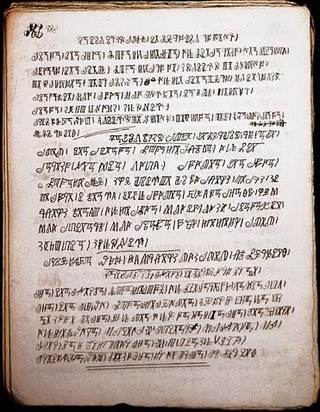Loading AI tools
Benue–Congo language spoken in Cameroon From Wikipedia, the free encyclopedia
Bamum (Shü Pamom [ʃŷpǎˑmə̀m] 'language of the Bamum', or Shümom 'Mum language'), also known as Shupamem, Bamun, or Bamoun, is an Eastern Grassfields language of Cameroon, with approximately 420,000 speakers.[1] The language is well known for its original script developed by King Njoya and his palace circle in the Kingdom of Bamum around 1895. Cameroonian musician Claude Ndam was a native speaker of the language and sang it in his music.[2]
| Bamum | |
|---|---|
| Shüpamom | |
| ꛀꛣꚧꚳ | |
| Region | Cameroon, Nigeria |
| Ethnicity | Bamum people |
Native speakers | 420,000 (2005)[1] |
| Dialects |
|
| Latin script, Bamum syllabary (being revived) | |
| Language codes | |
| ISO 639-3 | bax |
| Glottolog | bamu1253 |
 Page from a manuscript in the Bamum script | |
Bamum has tone, vowel length, diphthongs and coda consonants.
Nchare claims ten diphthongs, only eight of which (excluding /ɔ/ and /o/) have a length distinction.[3] Matateyou shows normal and long examples of all ten vowel qualities. The orthography in angle brackets was based on the General Alphabet of Cameroon Languages as used by Matateyou.[4]
The consonants are displayed as following:[5][4]
| Labial | Alveolar | Palatal | Velar | Labial- velar |
Glottal | ||||
|---|---|---|---|---|---|---|---|---|---|
| Plosive | Plain | Voiceless | p ⟨p⟩ | t ⟨t⟩ | k ⟨k⟩ | k͡p ⟨kp⟩ | ʔ ⟨ʼ⟩[a] | ||
| Voiced | b ⟨b⟩[b] | d ⟨d⟩[c] | ɡ ⟨g⟩[d] | g͡b ⟨gb⟩ | |||||
| Prenasal | Voiceless | ᵐp ⟨mp⟩ | ⁿt ⟨nt⟩ | ᵑk ⟨ŋk⟩ | ᵑ͡ᵐk͡p ⟨ŋkp⟩ | ||||
| Voiced | ᵐb ⟨mb⟩ | ⁿd ⟨nd⟩ | ᵑɡ ⟨ŋg⟩ | ᵑ͡ᵐg͡b ⟨ŋgb⟩ | |||||
| Fricative | Plain | Voiceless | f ⟨f⟩ | s ⟨s⟩ | ʃ ⟨sh⟩ | ||||
| Voiced | β[b] ⟨ɓ⟩[e] | v ⟨v⟩ | z ⟨z⟩[f] | ʒ ⟨j⟩[g] | ɣ ⟨gh⟩ | ||||
| Prenasal | Voiceless | ᶬf ⟨mf⟩ | ⁿs ⟨ns⟩ | ᶮʃ ⟨nsh⟩ | |||||
| Voiced | ᶬv ⟨mv⟩ | ⁿz ⟨nz⟩ | ᶮʒ ⟨nzh⟩ | ||||||
| Nasal | m ⟨m⟩ | n ⟨n⟩ | ɲ ⟨ny⟩ | ŋ ⟨ŋ⟩ | ŋ͡m ⟨ŋm⟩ | ||||
| Rhotic | r ⟨r⟩ | ||||||||
| Approximant | Plain | l ⟨l⟩ | j ⟨y⟩ | w ⟨w⟩ | |||||
| Prenasal | ⁿj ⟨nj⟩ | ⁿw ⟨nw⟩ | |||||||
Bamum has four[6] or five tones.[7] Mateteyou's analysis includes a mid tone, while Nchare's analysis includes downstep.[6] Bamum distinguishes between lexical and grammatical tone.[8]
| Diacritic | Nchare | Matateyou |
|---|---|---|
| à | low | low |
| á | high | high |
| ā | ― | mid |
| ǎ | rising | rising |
| â | falling | falling |
| ꜜ | downstep | ― |
Seamless Wikipedia browsing. On steroids.
Every time you click a link to Wikipedia, Wiktionary or Wikiquote in your browser's search results, it will show the modern Wikiwand interface.
Wikiwand extension is a five stars, simple, with minimum permission required to keep your browsing private, safe and transparent.